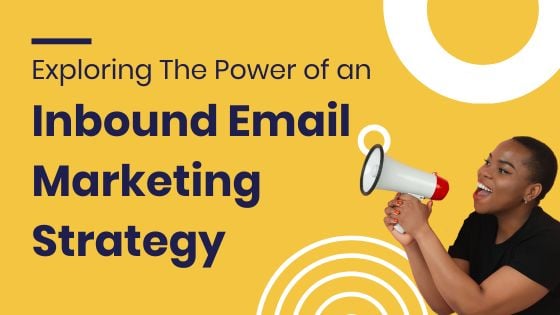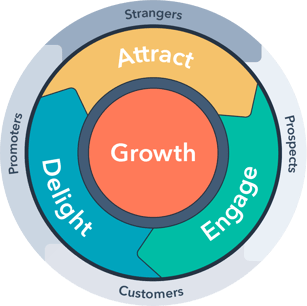


Exploring The Power Of An Inbound Email Marketing Strategy




Creating an inbound email marketing strategy means crafting campaigns that align with the customer's journey and interests. It's about moving away from intrusive, broadcast-style emails and towards more personalised, permission-based communications. Inbound email marketing seeks to provide value to the recipient, engaging them with content that is timely, relevant, and helpful, ultimately guiding them through the sales funnel in a non-disruptive way.
In this blog, we'll get into the basics of inbound methodology and how you can utilise it to build a successful inbound email marketing strategy
Understanding Inbound Email Marketing Strategy
Inbound marketing is all about reaching the right people at the right time with the right information. Instead of reaching out to people, you instead focus on attracting them by creating content that resonates with your buyer persona and ICP.
Here's a short video to better illustrate inbound marketing:
What is an Inbound Email Marketing Strategy?
With an inbound email marketing strategy up your sleeve, you can transform the way you connect with your audience. The focus of an inbound methodology is to draw your customers in instead of reaching out to (or intruding) them through traditional advertising or marketing methods.
An inbound email marketing strategy focuses on attracting subscribers through engaging, relevant content and nurturing these relationships until they are ready to purchase.
Why do you need an Inbound Email Marketing Strategy?
The importance of inbound email marketing lies in its efficiency and effectiveness. By targeting users who have already shown an interest in your product or service, you significantly increase the chances of conversion.
Moreover, it helps build trust and loyalty with your customer base by providing valuable information and personalised experiences.
Your customers are being bombarded with countless notifications from an ‘n’ number of brands, an inbound approach will give you the edge and cut through the noise, ensuring their messages are seen by the right people at the right time.
What we're doing here is playing it smart by focusing on the right crowd. It's all about making your marketing efforts count and really hitting home with those who are ready to listen. And guess what? It makes the whole experience way better for everyone involved. Your messages hit the mark every time – they're relevant, they're timely, and they're just what your audience wants.
This isn't just good marketing; it's building trust and loyalty that keep customers coming back for more.
Inbound email marketing isn't just about fighting to be seen in a crowded market. It's your chance to connect on a real level with potential customers. It's about creating relationships that aren't just good for growth but are all about sustainable success.
Stages of Inbound Methodology
Inbound email marketing unfolds in stages, each critical to nurturing a deep, lasting connection with your audience.

1. The first stage is Attraction. Here, you're drawing in the right people with valuable content that resonates. This could be through insightful blog posts, compelling videos, or infographics that speak directly to the needs and interests of your potential customers.
2. Following attraction is the Conversion stage. Now that you've piqued their interest, it's about turning those interested visitors into leads. This involves offering something of value in exchange for their contact information—think free ebooks, whitepapers, or webinars.
3. The key here is to ensure that there's Delight. In this stage, your focus shifts to transforming customers into advocates for your brand. This involves going above and beyond in providing exceptional service and support, as well as engaging them with content and offers that encourage repeat business and referrals.
Throughout these stages, analysis and optimisation play a continuous role. By evaluating the effectiveness of your efforts at each step and refining your strategy accordingly, inbound email marketing becomes not just a method of outreach but a cycle of sustained growth and engagement.
Now let's incorporate inbound methodology in our email marketing strategy and explore how we can implement a successful inbound email marketing strategy:
What occurs during the attract stage of the inbound methodology?
The attraction phase of inbound email marketing is a crucial aspect that sets the tone for the entire customer journey. Here are some key strategies to captivate your audience during this phase, let's get into what occurs during the attract stage of the inbound methodology:
Craft compelling subject lines
The subject line is the first interaction subscribers have with your email, making it essential to pique curiosity, convey value, and create urgency. Personalisation, including addressing subscribers by name or tailoring subject lines to preferences, significantly boosts open rates. Key tips include maintaining clarity, avoiding ambiguity, and conducting A/B testing to identify resonant subject lines.Segment your audience for personalisation
By categorising subscribers based on demographics, behavioural data, purchase history, and engagement levels, you can send targeted, personalised messages that align with specific needs. Effective segmentation enhances email relevancy, resulting in higher open and click-through rates.Utilise high-quality content to woo your subscribers
From educational articles and entertaining videos to exclusive offers and storytelling, content should align with audience interests. These strategies not only attract subscribers but also keep them engaged over the long term, fostering brand loyalty and customer satisfaction.
When does the engage stage of the inbound methodology begin?
The engage stage of the inbound methodology in email marketing begins when your subscriber takes a specific action that indicates their interest or intent. This could be anything from opening an email, clicking on a link within an email, responding to a survey, or downloading content offered through an email campaign.
At this point, the potential customer has moved beyond the awareness stage, where they were simply receiving information, to actively interacting with the content provided. This phase involves a strategic approach to captivate recipients, foster interaction, and ultimately build lasting relationships. Three key components contribute significantly to the success of the engagement phase:
Creating Interactive and Valuable Content
In this phase, we focus on crafting emails that are not only visually appealing but also provide substantial value to the recipients. Interactive elements, such as personalised recommendations, surveys, and clickable calls-to-action, enhance the user experience, encouraging active participation.
Implementing Automated Email Workflows
Automated email workflows ensure timely and relevant communication by triggering messages based on specific user actions or predefined timelines. Whether it's onboarding sequences, abandoned cart reminders, or exclusive offers, automated workflows streamline communication, saving time and resources while maintaining a consistent and engaging brand presence.
Monitoring Engagement Metrics and Adjusting Strategies
You should closely monitor key metrics such as open rates, click-through rates, and conversion rates to gauge the effectiveness of your email campaigns. Analysing these metrics provides valuable insights into audience behaviour and preferences, enabling marketers to make data-driven decisions
The goal during this stage is to nurture this interest into a strong relationship, guiding them towards making a purchase decision or other desired conversion action.
What is the purpose of the delight stage of the inbound methodology?
The delight stage plays a key role in turning current customers into loyal brand advocates when we aim to surpass expectations by offering content that not only meets but also surprises their audience.
By consistently delivering delightful email experiences, companies can build a group of enthusiastic supporters who are more likely to recommend the brand and make repeat purchases, thus attracting and engaging new potential customers more effectively. To achieve this, several key strategies come into play:
Providing Exceptional Post-Purchase Support
Email communication becomes a valuable channel for providing order updates, addressing queries, and ensuring a seamless post-purchase experience. By prioritising customer satisfaction, businesses can transform one-time buyers into loyal advocates.
Encouraging Feedback and User-Generated Content
Feedback is a powerful tool for improvement and community building and we can leverage emails to actively seek customer feedback through surveys, encouraging users to share their experiences. Moreover, the integration of user-generated content, such as reviews and testimonials, into email campaigns adds authenticity and strengthens the brand-consumer relationship.
Exclusive Offers and Content for Loyal Subscribers
By making these subscribers feel valued and appreciated by offering them exclusive discounts, and early access to promotions or specialised content, we can enhance customer retention and create a positive feedback loop.
Diving into the nitty-gritty, we've taken a stroll through inbound methodology, highlighting its role in cultivating trust, loyalty, and a kind of success that doesn't fade with the next tide. We've talked about Attraction, Conversion, and Delight – each stage is an essential ingredient in the recipe for lasting relationships with our audience. By incorporating these strategies, businesses can not only stand out in a crowded market but also foster genuine relationships that drive sustained growth and engagement.







